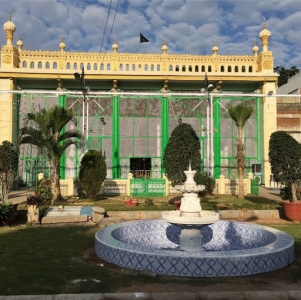Hyderabad’s 430-year-old Badshahi Ashoorkhana to be restored by AKTC 2022-12-29
Hyderabad: The Ministry of Municipal Administration and Urban Development (MAUD) on Thursday announced the restoration of the historic Badshahi Ashoorkhana.
Following the survey of the Badshahi Ashurkhana, urban development secretary Arvind Kumar stated that the Aga Khan Trust and the Quli Qutub Shah Urban Development Authority (QQSUDA) will restore the lime plaster and consolidate the structure.
Kumar further said that emphasis will be laid on strengthening the roofing and flooring of the Ashoorkhana. It is to be noted that in May this year the Hyderabad Metropolitan Water Supply and Sewerage Board (HMWSSB) broke the outer wall of the Ashoorkhana.
The HMWSSB said that the step was taken to execute sewerage works in the year. However, the Badshahi Ashoorkhana’s administrators have alleged that the boundary wall and the monument are in fact subject matter to a court ruling, which has reportedly been flouted.
In a letter to Telangana chief secretary Somesh Kumar and other authorities, Mutawalli Mujawer of the Ashoorkhana Mir Abbas Ali Moosvi said that if the boundary wall of the Badshahi Ashoorkhana is not erected again, there is a possibility that the outer area of the monument may be encroached by the ”politically influenced encroachers”.
Adding that if the wall is not rebuilt, then it may lead to disturbances within the Muslim community.
The Ashoorkhana is a protected heritage site and is the second oldest monument of Hyderabad, as it was built immediately after the Charminar, which was constructed as the city’s foundation in 1591 by Mohd Quli Qutb Shah of the Golconda or Qutb Shahi dynasty (1518-1687).
Though some ancillary structures in the open ground like Naqar Khana, Abdar Khana and Niyaz Khana have suffered intense damage, however, the main hall of the Badshahi Ashoorkhana remains intact. Walls decked up with multicoloured tiles and the dominant theme of flaming Alams is the cynosure of all eyes here.
A mosaic of staggered hexagons with jewel-like shapes fills the arch on the southern wall. Typical Indian colours like mustard yellow and brown add vibrancy to the panel on the western wall while the north-west wall sports a large ‘Alam’ in the centre of the side panels. Circling swirls of flowers and leaves surround the compositions.
The walls of this historic structure were damaged during the floods of 1908. and were temporarily repainted in a similar design.
Significance of the Badshahi Ashoorkhana
The Badshahi Ashoorkhana was constructed between 1592-96, sometime after the Charminar was built in 1591. Like other Ashoorkhanas, this one too saw bad days for nearly a century after the Qutb Shahi dynasty fell to Aurangzeb’s army in 1687. And it wasn’t until Nizam Ali (the second monarch of the Asaf Jahi dynasty) came to power that the Badshahi Ashoorkhana was given an annual grant.
An Ashoorkhana is where Shia Muslims mourn during Ashura, the 10th of Moharram. The place is dedicated to Imam Hussain, a grandson of Prophet Muhammad who was killed in the battle of Karbala. Hussain was the son of Imam Ali, the prophet’s son-in-law (and cousin).
=======================================================================================================================
Badshahi Ashurkhana is an ashurkhana near Charminar in Hyderabad, India. It was constructed in memory of martyrdom of Imam Hussain, and is used during the mourning period of Moharram. Wikipedia
- 243 reads

